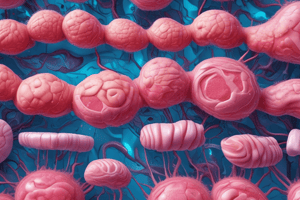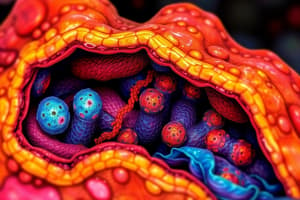Podcast
Questions and Answers
What is primary intention healing characterized by?
What is primary intention healing characterized by?
- Significant tissue loss and prolonged healing time
- Wounds left open for drainage
- Minimal granulation tissue and minimal scarring (correct)
- Increased risk of infection
Which type of healing is applied to wounds with considerable tissue loss?
Which type of healing is applied to wounds with considerable tissue loss?
- Primary intention healing
- Immediate intention healing
- Tertiary intention healing
- Secondary intention healing (correct)
What is a significant difference between primary and secondary intention healing?
What is a significant difference between primary and secondary intention healing?
- Secondary intention requires sutures for closure
- Secondary intention produces less granulation tissue
- Primary intention has shorter repair time than secondary intention (correct)
- Primary intention involves greater susceptibility to infection
What can happen if a wound undergoes dehiscence?
What can happen if a wound undergoes dehiscence?
Which factor does NOT increase the risk of wound dehiscence?
Which factor does NOT increase the risk of wound dehiscence?
What characterizes tertiary intention healing?
What characterizes tertiary intention healing?
What is a common appearance of granulation tissue during healing?
What is a common appearance of granulation tissue during healing?
When is wound dehiscence most likely to occur postoperatively?
When is wound dehiscence most likely to occur postoperatively?
What is serous exudate primarily characterized by?
What is serous exudate primarily characterized by?
Which type of exudate is described as containing a large amount of pus?
Which type of exudate is described as containing a large amount of pus?
What do mixed types of exudate often indicate?
What do mixed types of exudate often indicate?
What does bright sanguineous exudate usually signify?
What does bright sanguineous exudate usually signify?
Which of the following is NOT true regarding purulent exudate?
Which of the following is NOT true regarding purulent exudate?
Flashcards
Primary Intention Healing
Primary Intention Healing
Healing process where wound edges are closed and there's minimal tissue loss, resulting in less scarring.
Secondary Intention Healing
Secondary Intention Healing
Healing method for wounds with extensive tissue loss where edges are not closed. Longer healing time, more scarring, and higher infection risk.
Tertiary Intention Healing
Tertiary Intention Healing
Healing where a wound is left open initially, then closed later. Combines aspects of primary and secondary healing.
Granulation Tissue
Granulation Tissue
Signup and view all the flashcards
Wound Dehiscence
Wound Dehiscence
Signup and view all the flashcards
Evisceration
Evisceration
Signup and view all the flashcards
Dehiscence Risk Factors
Dehiscence Risk Factors
Signup and view all the flashcards
Comorbidities
Comorbidities
Signup and view all the flashcards
Exudate
Exudate
Signup and view all the flashcards
Serous Exudate
Serous Exudate
Signup and view all the flashcards
Purulent Exudate
Purulent Exudate
Signup and view all the flashcards
Sanguineous Exudate
Sanguineous Exudate
Signup and view all the flashcards
Purosanguineous Exudate
Purosanguineous Exudate
Signup and view all the flashcards
Study Notes
Tissue Regeneration and Healing
- Tissue regeneration, or healing, is influenced by the extent of tissue loss.
- Primary intention healing (primary union/first intention):
- Occurs when tissue surfaces are approximated (closed).
- Minimal tissue loss.
- Minimal granulation tissue and scarring.
- Examples: closed surgical incisions, wound closure with staples, tapes, or adhesive.
- Characterized by minimal exudate.
- Secondary intention healing:
- Occurs in extensive wounds with significant tissue loss, where edges cannot or should not be closed.
- Longer repair time.
- Greater scarring.
- Higher susceptibility to infection.
- Examples: pressure injuries.
- Characterized by the production of more exudate.
- Tertiary intention healing (delayed primary intention):
- Wounds left open for 3-5 days to allow edema, infection resolution, or exudate drainage before closure.
- Similar healing process to primary intention but with an open period initially.
- Characterized by the amount of exudate produced during the open period.
Wound Complications
- Dehiscence: Partial or total rupture of a sutured wound, commonly in abdominal wounds.
- Evisceration: Internal organs protruding through the incision.
- Risk factors for wound dehiscence:
- Obesity
- Poor nutrition
- Multiple traumas
- Suturing failure
- Excessive coughing or vomiting
- Dehydration
- Comorbidities like diabetes.
- Types of exudate can be a predictor.
- Potential dehiscence time: 4-5 days post-operatively (before large collagen deposition).
Wound Exudate
- Exudate: Fluid and dead phagocytic cells escaped from blood vessels during inflammation.
- Type and amount of exudate vary:
- Based on tissue involved.
- Inflammation intensity/duration.
- Microorganism presence.
- Exudate Types:
- Serous: Mild inflammation, clear/straw-colored, thin, watery, few cells (e.g., blister fluid).
- Purulent: Thicker, opaque/milky, high cell and necrotic debris content, often called pus, caused by pyogenic bacteria. May present with tinges of blue, green, or yellow. Color varies based on causative organism.
- Sanguineous (hemorrhagic): High RBC count, severe capillary damage, allowing RBC escape. Fresh bleeding (bright) or older bleeding (dark). Frequent in open wounds.
- Mixed types: Common; examples include serosanguineous (clear/blood-tinged) in surgical incisions, and purulent-sanguineous (pus/blood) in infected wounds.
Studying That Suits You
Use AI to generate personalized quizzes and flashcards to suit your learning preferences.



